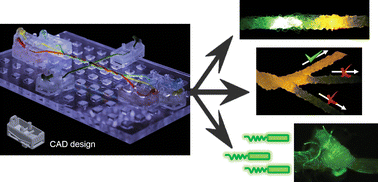Fibre-based electrofluidics on low cost versatile 3D printed platforms for solute delivery, separations and diagnostics; from small molecules to intact cells†
Abstract
A novel and effective fibre-based microfluidic methodology was developed to move and isolate charged solutes, biomolecules, and intact bacterial cells, based upon a novel multi-functional 3D printed supporting platform, with potential applications in the fields of microfluidics and biodiagnostics. Various on-fibre electrophoretic techniques are demonstrated to separate, pre-concentrate, move, split, or cut and collect the isolated zones of target solutes, including proteins and live bacterial cells. The use of knotting to link different fibre materials, and the unique ability of this approach to physically concentrate solutes in different locations are shown such that the concentrated solutes can be physically isolated and easily transferred to other fibres. Application of this novel fibre-based technique within a potential diagnostic platform for urinary tract infection is shown, together with the post-electrophoretic incubation of live bacterial cells, demonstrating the cell survival following on-fibre electrophoretic concentration.

- This article is part of the themed collection: In memory of Craig Lunte

 Please wait while we load your content...
Please wait while we load your content...